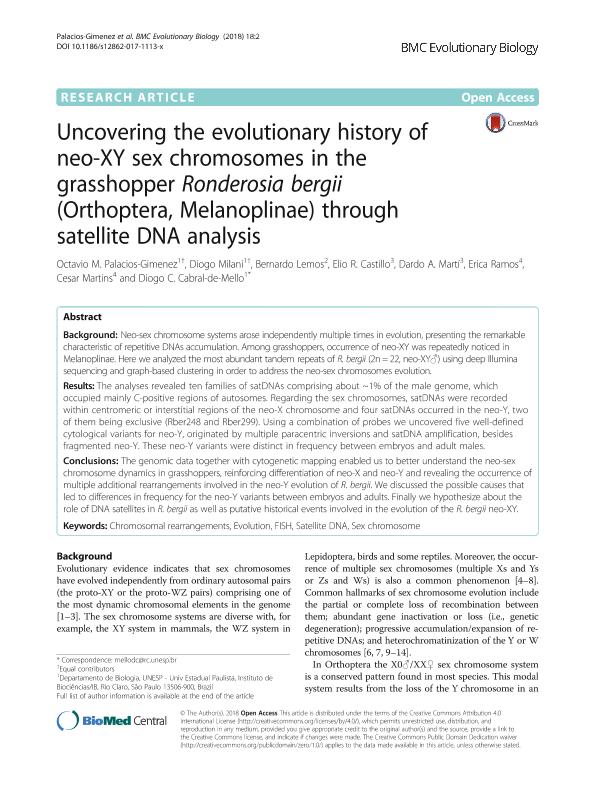Mostrar el registro sencillo del ítem
dc.contributor.author
Palacios Gimenez, Octavio M.
dc.contributor.author
Milani, Diogo
dc.contributor.author
Lemos, Bernardo
dc.contributor.author
Castillo, Elio Rodrigo Daniel

dc.contributor.author
Marti, Dardo Andrea

dc.contributor.author
Ramos, Erica
dc.contributor.author
Cabral De Mello, Diogo C.
dc.contributor.author
Martins, Cesar
dc.date.available
2019-10-17T20:24:05Z
dc.date.issued
2018-01
dc.identifier.citation
Palacios Gimenez, Octavio M.; Milani, Diogo; Lemos, Bernardo; Castillo, Elio Rodrigo Daniel; Marti, Dardo Andrea; et al.; Uncovering the evolutionary history of neo-XY sex chromosomes in the grasshopper Ronderosia bergii (Orthoptera, Melanoplinae) through satellite DNA analysis; BioMed Central; BMC Evolutionary Biology; 18; 2; 1-2018; 1-10
dc.identifier.issn
1471-2148
dc.identifier.uri
http://hdl.handle.net/11336/86191
dc.description.abstract
Background: Neo-sex chromosome systems arose independently multiple times in evolution, presenting the remarkable characteristic of repetitive DNAs accumulation. Among grasshoppers, occurrence of neo-XY was repeatedly noticed in Melanoplinae. Here we analyzed the most abundant tandem repeats of R. bergii (2n = 22, neo-XY♂) using deep Illumina sequencing and graph-based clustering in order to address the neo-sex chromosomes evolution. Results: The analyses revealed ten families of satDNAs comprising about ~1% of the male genome, which occupied mainly C-positive regions of autosomes. Regarding the sex chromosomes, satDNAs were recorded within centromeric or interstitial regions of the neo-X chromosome and four satDNAs occurred in the neo-Y, two of them being exclusive (Rber248 and Rber299). Using a combination of probes we uncovered five well-defined cytological variants for neo-Y, originated by multiple paracentric inversions and satDNA amplification, besides fragmented neo-Y. These neo-Y variants were distinct in frequency between embryos and adult males. Conclusions: The genomic data together with cytogenetic mapping enabled us to better understand the neo-sex chromosome dynamics in grasshoppers, reinforcing differentiation of neo-X and neo-Y and revealing the occurrence of multiple additional rearrangements involved in the neo-Y evolution of R. bergii. We discussed the possible causes that led to differences in frequency for the neo-Y variants between embryos and adults. Finally we hypothesize about the role of DNA satellites in R. bergii as well as putative historical events involved in the evolution of the R. bergii neo-XY.
dc.format
application/pdf
dc.language.iso
eng
dc.publisher
BioMed Central

dc.rights
info:eu-repo/semantics/openAccess
dc.rights.uri
https://creativecommons.org/licenses/by-nc-sa/2.5/ar/
dc.subject
CHROMOSOMAL REARRANGEMENTS
dc.subject
EVOLUTION
dc.subject
FISH
dc.subject
SATELLITE DNA
dc.subject
SEX CHROMOSOME
dc.subject.classification
Genética y Herencia

dc.subject.classification
Ciencias Biológicas

dc.subject.classification
CIENCIAS NATURALES Y EXACTAS

dc.title
Uncovering the evolutionary history of neo-XY sex chromosomes in the grasshopper Ronderosia bergii (Orthoptera, Melanoplinae) through satellite DNA analysis
dc.type
info:eu-repo/semantics/article
dc.type
info:ar-repo/semantics/artículo
dc.type
info:eu-repo/semantics/publishedVersion
dc.date.updated
2019-09-27T14:56:45Z
dc.journal.volume
18
dc.journal.number
2
dc.journal.pagination
1-10
dc.journal.pais
Reino Unido

dc.journal.ciudad
Londres
dc.description.fil
Fil: Palacios Gimenez, Octavio M.. Universidade Estadual Paulista Julio de Mesquita Filho; Brasil
dc.description.fil
Fil: Milani, Diogo. Universidade Estadual Paulista Julio de Mesquita Filho; Brasil
dc.description.fil
Fil: Lemos, Bernardo. Harvard University. Harvard School of Public Health; Estados Unidos
dc.description.fil
Fil: Castillo, Elio Rodrigo Daniel. Consejo Nacional de Investigaciones Científicas y Técnicas. Centro Científico Tecnológico Conicet - Nordeste. Instituto de Biología Subtropical. Universidad Nacional de Misiones. Instituto de Biología Subtropical; Argentina
dc.description.fil
Fil: Marti, Dardo Andrea. Consejo Nacional de Investigaciones Científicas y Técnicas. Centro Científico Tecnológico Conicet - Nordeste. Instituto de Biología Subtropical. Universidad Nacional de Misiones. Instituto de Biología Subtropical; Argentina
dc.description.fil
Fil: Ramos, Erica. Universidade Estadual Paulista Julio de Mesquita Filho; Brasil
dc.description.fil
Fil: Cabral De Mello, Diogo C.. Universidade Estadual Paulista Julio de Mesquita Filho; Brasil
dc.description.fil
Fil: Martins, Cesar. Universidade Estadual Paulista Julio de Mesquita Filho; Brasil
dc.journal.title
BMC Evolutionary Biology

dc.relation.alternativeid
info:eu-repo/semantics/altIdentifier/url/https://bmcevolbiol.biomedcentral.com/articles/10.1186/s12862-017-1113-x
dc.relation.alternativeid
info:eu-repo/semantics/altIdentifier/doi/http://dx.doi.org/10.1186/s12862-017-1113-x
Archivos asociados
